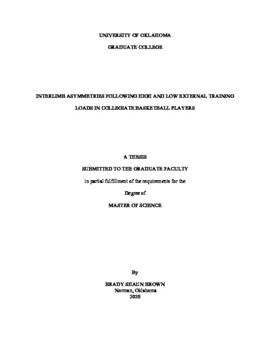| dc.description.abstract | Interlimb asymmetry refers to the performance of an extremity in relation to the other. This imbalance between limbs has often been considered a risk factor for injury, as well as a dynamic performance inhibitor. However, limited evidence exists on the prevalence of acute development of asymmetry from external load prescription. PURPOSE: The primary purpose of the present study was to evaluate functional performance differences in asymmetry pre-, immediately post-, and 24h post-basketball specific training. The secondary purpose was to evaluate the significance of sex differences in asymmetry pre-, immediately post-, and 24h post-basketball specific training. METHODS: A convenience sample of 20 (males = 12; females = 8) NCAA Division I collegiate basketball players were enrolled in the present study. The 1st visit consisted of a consent and familiarization, the 2nd and 4th consisted of pre-post countermovement jump (CMJ) testing, along with randomized cross-over designed basketball practice load prescription, while the 3rd and 5th visit consisted of solely a warmup and (CMJ) test. The 2nd and 4th visits consisted of a randomized training load, hereafter referred to as the “High” or “Low” conditions. RESULTS: Only Eccentric Mean Force displayed significance (p = 0.004) between training loads, across time points for Change Scores. There were no significant sex differences between condition and time, however small effect sizes were identified for Asymmetry Scores with Concentric Impulse, Concentric Mean Force, Concentric Peak Force, Eccentric Peak Force, Force at Zero Velocity, Force at Peak Power, and Takeoff Peak Force Pre to Post- and Post to 24hPost- for females (d = 0.20-0.49), while males exhibited trivial effects (d < 0.20). Additionally, we saw large effects within males and females in Change Scores (d > 0.80), with Concentric Impulse, Concentric Mean Force, Eccentric Mean Force, Force at Peak Power, and Takeoff Peak Force Pre to Post- in males, while females revealed small (d = 0.20-0.49) to moderate (d = 0.50-0.79) effects. CONCLUSIONS: It appears that Eccentric Mean Force may be a valuable metric to detect acute changes in asymmetry during the CMJ following offseason basketball specific training. Additionally important to note, practitioners may note sex differences in asymmetry change following offseason specific basketball training. These findings may also be exacerbated in different training phases throughout the year, in conjunction with increased intensities and training loads. | en_US |

